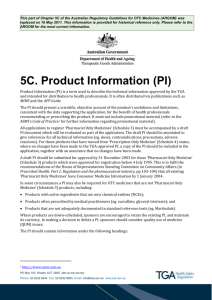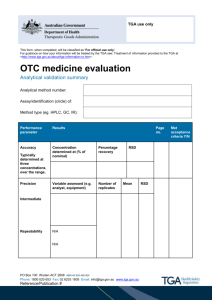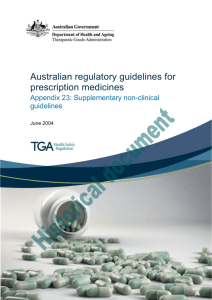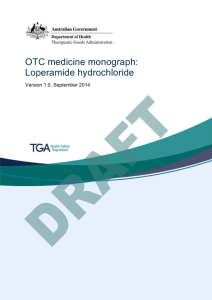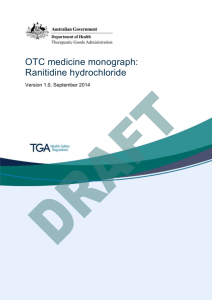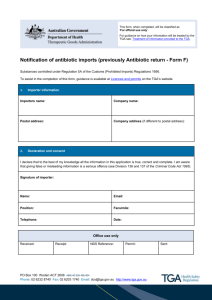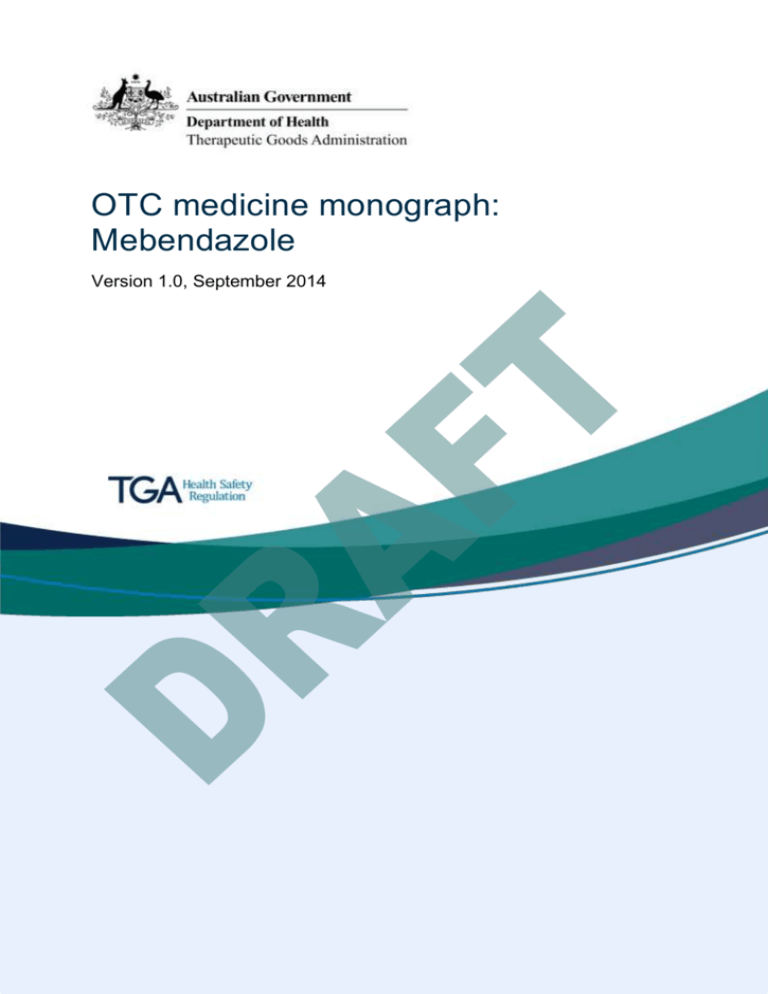
OTC medicine monograph:
Mebendazole
Version 1.0, September 2014
Therapeutic Goods Administration
About the Therapeutic Goods Administration
(TGA)
The Therapeutic Goods Administration (TGA) is part of the Australian Government
Department of Health, and is responsible for regulating medicines and medical devices.
The TGA administers the Therapeutic Goods Act 1989 (the Act), applying a risk management
approach designed to ensure therapeutic goods supplied in Australia meet acceptable
standards of quality, safety and efficacy (performance), when necessary.
The work of the TGA is based on applying scientific and clinical expertise to decisionmaking, to ensure that the benefits to consumers outweigh any risks associated with the use
of medicines and medical devices.
The TGA relies on the public, healthcare professionals and industry to report problems with
medicines or medical devices. TGA investigates reports received by it to determine any
necessary regulatory action.
To report a problem with a medicine or medical device, please see the information on the
TGA website <http://www.tga.gov.au>.
Copyright
© Commonwealth of Australia 2014
This work is copyright. You may reproduce the whole or part of this work in unaltered form for your own personal use or, if
you are part of an organisation, for internal use within your organisation, but only if you or your organisation do not use the
reproduction for any commercial purpose and retain this copyright notice and all disclaimer notices as part of that
reproduction. Apart from rights to use as permitted by the Copyright Act 1968 or allowed by this copyright notice, all other
rights are reserved and you are not allowed to reproduce the whole or any part of this work in any way (electronic or
otherwise) without first being given specific written permission from the Commonwealth to do so. Requests and inquiries
concerning reproduction and rights are to be sent to the TGA Copyright Officer, Therapeutic Goods Administration, PO Box
100, Woden ACT 2606 or emailed to <tga.copyright@tga.gov.au>
Confidentiality
All submissions received will be placed on the TGA’s Internet site, unless marked confidential. Any confidential material
contained within your submission should be provided under a separate cover and clearly marked “IN CONFIDENCE”.
Reasons for a claim to confidentiality must be included in the space provided on the TGA submission coversheet. For
submission made by individuals, all personal details, other than your name, will be removed from your submission before it
is published on the TGA’s Internet site. In addition, a list of parties making submissions will be published. If you do not wish
to be identified with your submission you must specifically request this in the space provided on the submission coversheet.
Therapeutic Goods Administration
Version history
Version
Description of change
Author
Effective date
V1.0
Original publication
OTC Medicines
Evaluation/OMA
XX/XX/XX
OTC medicine monograph: Mebendazole
V1.0 September 2014
Page 3 of 9
Therapeutic Goods Administration
Contents
Introduction ___________________________________ 5
Active substance _______________________________ 5
Dosage forms and strengths _____________________ 5
Indications ____________________________________ 5
Therapeutic indications for inclusion in the Australian Register of
Therapeutic Goods (ARTG) ___________________________________________________ 5
Label indication ________________________________________________________________ 5
Directions for use ______________________________ 6
Additional instructions _______________________________________________________ 6
Labels ________________________________________ 7
Quality requirements ___________________________ 7
Finished product specifications _____________________________________________ 7
Mebendazole tablet ------------------------------------------------------------------------- 7
Mebendazole oral suspension ------------------------------------------------------------ 7
OTC medicine monograph: Mebendazole
V1.0 September 2014
Page 4 of 9
Therapeutic Goods Administration
Introduction
This OTC Medicine Monograph outlines the requirements for Australian market authorisation of
oral medicines containing mebendazole as a single active ingredient when applied for as an OTC
New Medicine N2 application. Proposed medicines must comply with all aspects of the
monograph relevant to their strength and dosage form to qualify for evaluation as an N2
application.
This monograph should be read in conjunction with the document Requirements for OTC new
medicines N2 applications.
Active substance
This monograph only applies to medicines containing mebendazole (CAS no. 31431-39-7) and
excludes any preparations containing any other salts and derivatives of mebendazole.
Dosage forms and strengths
Acceptable dosage form and strengths are shown in the table below.
Active substance
Dosage strength
Dosage forms
Mebendazole
100 mg
Tablet (chewable and uncoated only)
20 mg/mL
Oral suspension
Indications
Therapeutic indications for inclusion in the Australian
Register of Therapeutic Goods (ARTG)
Treatment of Enterobius vermicularis (threadworm or pinworm).
For the treatment of other worms such as Ascaris lumbricoides (roundworm), Trichuris trichura
(whipworm) and Ancylostoma duodenale and Necator americanus (hookworm) only under
medical supervision.
Label indication
Treatment of threadworm.
In addition to the above label indications, the following label claims may be included:
Kills worms.
Treatment of roundworm, whipworm and hookworms only on medical advice#.
Note: As roundworm, hookworm and whipworm rarely occur in the general Australian population, treatment for these types of
worms need to be under medical supervision. Therefore, this claim will be accepted if included on the back panel of the carton label.
#
OTC medicine monograph: Mebendazole
V1.0 September 2014
Page 5 of 9
Therapeutic Goods Administration
Directions for use
Adults and children 2 years of age and over:
Dosage form
Dosage
100 mg tablet
For the treatment of threadworm: 1 tablet to be taken as a single
dose. It may be taken with or without food.
The tablet may be swallowed whole, chewed* or crushed.
It is recommended that children chew the tablets*. If preferred, the
tablet may be crushed and mixed with food or juice before giving to
children.
*only if formulated also as chewable tablet.
20 mg/mL
suspension
For the treatment of threadworm: Shake the bottle well before use.
Give/take 5 mL of suspension as a single dose. It may be taken with or
without food.
Do not give to children under 2 years of age.
If you are pregnant or may become pregnant, check with your doctor or pharmacist before
taking this medicine.
Roundworm, hookworm and whipworm rarely occur in the general Australian population. If
suspected, seek medical advice before you start treatment. If treating this condition, ask your
doctor for the correct dose. The recommended dosage for this condition in adults and children
aged 2 years and over is 100 mg (1 tablet or 5 mL of suspension) twice a day for three days.
Additional instructions
The following instructions are required:
Threadworms or pinworms are small, very thin worms that look like white threads.
Before treating for threadworm, evidence of infestation should be present.
Signs and symptoms of threadworm infestation include:
–
The presence of tiny white threads around the anal region.
–
Itching around the anus and vagina, which may result in restless sleep, grinding of teeth
and irritability.
If a household member has threadworms, then each member should be treated.
If symptoms persist, see your doctor.
To help reduce infection and prevent reinfestation, the following measures may be included:
Treat all other household members at the same time, even if others have no symptoms,
because the worms spread very easily.
Keep fingernails short and ensure hands and nails are scrubbed clean.
OTC medicine monograph: Mebendazole
V1.0 September 2014
Page 6 of 9
Therapeutic Goods Administration
Wash hands after using the toilet and before eating.
Shower rather than bathe for several days after treatment.
Vacuum carpet and wash floors, clothing and linen in hot water.
If reinfestation occurs, repeat treatment 2-4 weeks after initial dose.
Labels
Labelling must comply with all relevant Australian requirements, as detailed in the document
Requirements for OTC new medicines N2 applications, including all required warning
statements.
Quality requirements
In addition to the quality requirements outlined in the document Requirements for OTC new
medicines N2 applications, the following specific requirements apply to mebendazole
monograph medicine:
Finished product specifications
In addition to other requirements specified in the document Requirements for OTC new
medicines N2 applications, the finished product specifications must comply, at a minimum, with
the relevant set of requirements below.
The requirements below include all relevant USP General Chapter requirements and TGO 78
requirements. Further reference to these is not required. References to the pharmacopoeial
monographs below refer to the current monographs at the time of application.
Mebendazole tablet
The tests and limits in the USP monograph Mebendazole Tablets with the addition of:
tablet appearance
content of mebendazole (NLT 92.5% and NMT 107.5%)1 in compliance with TGO 78
individual unspecified impurities (NMT 0.5%); and total impurities (NMT 1.0%) and
microbiological quality in compliance with TGO 77.
Mebendazole oral suspension
The tests and limits in the USP monograph Mebendazole Oral Suspension with the addition of:
solution appearance
individual unspecified impurities (NMT 0.5%); and total impurities (NMT 1.0%)
1
in place of the Mebendazole Tablets USP requirement of NLT 90.0% and NMT 110.0%
OTC medicine monograph: Mebendazole
V1.0 September 2014
Page 7 of 9
Therapeutic Goods Administration
content of any preservatives included in the formulation and
microbiological quality in compliance with TGO 77.
OTC medicine monograph: Mebendazole
V1.0 September 2014
Page 8 of 9
Therapeutic Goods Administration
PO Box 100 Woden ACT 2606 Australia
Email: info@tga.gov.au Phone: 1800 020 653 Fax: 02 6232 8605
http://www.tga.gov.au
Reference/Publication #

